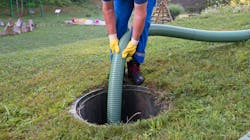Household septic systems are important for public health. If their operation and maintenance are not correctly maintained, local water quality can suffer.
One in five households in the United States uses a septic system to treat their wastewater. These systems are used to treat and dispose of relatively small volumes of wastewater, usually in suburban and rural locations not served by a centralized public sewer system. Septic systems treat wastewater through both natural and technological processes, typically beginning with solids settling in a tank, and ending with wastewater treatment in the soil via the drain field.
Every day, four billion gallons of wastewater are discharged into groundwater. When this wastewater is untreated, or comes from a malfunctioning septic system, bacteria, viruses, and dangerous chemicals can make their way into the environment through streams, rivers, and lakes; harming local plants and animals.
An example of the link between septic systems and water quality can be found in Florida’s Indian River drainage basin. This connection is present in the local salt lagoons with household septic systems located at or near the shoreline. There are 300,000 septic systems in close proximity to the Indian River lagoon, treating 50 percent of the area’s wastewater.
In a recent study, Florida Atlantic University researchers examined water quality at 20 sites. The team found that shallow ecosystems have a hard time breaking down pollution — even properly functioning septic systems were also shown to add excess pollution to groundwater, and Florida’s sediments (sandy soil and limestone) were found to be insufficient for removing nutrient pollution from septic systems.
Regular inspection and frequent pumping are an important part of septic system maintenance. The average household septic system should be inspected at least every three years by a septic service professional and pumped out every three to five years.
Trash is a common source of problems for septic systems. Many items should not be disposed of in a septic system — such as cooking grease, cat litter, diapers, household chemicals, coffee grounds, and “flushable” wipes. These items generally cannot be digested by bacteria, or can clog drainpipes and bind drain fields.
Waste haulers are responsible for removing all solids, including the trash, present in the septic system and carrying this to final disposal. Final disposal of septage is done by either land application or further treatment by disposal in a publicly owned treatment works.
Many facilities that dispose of septage choose to screen out trash that is present. A septage receiving station is a common type of equipment designed for this purpose. Typical features of a septage receiving station include a mechanical screen to capture trash and a compaction device to clean and dewater solids for easier disposal. The best construction material for handling septage is stainless steel, as it’s suited for the aggressive environment.
Septic systems are important for pollution control. Best practices to maintain high effluent water quality include disposing of the right material with inspection and periodic solids removal by a septic service professional. Final waste disposal requires removal of trash that does find its way into these systems. Septage receivers can be built to handle this tough work. A properly maintained septic system requires regular maintenance, monitoring, and an understanding of the location geology; still, these systems may pose a threat to water quality. WW
About the Author: Jay R. Conroy is President of Hydro-Dyne Engineering, Inc. a manufacturer of screening, screening handling, and grit removal equipment. He serves on WWEMA’s Board of Directors, is the Association’s Assistant Treasurer, and member of the Legislative & Regulatory and Marketing & Member Services Committees, having served as the former Chair of the Marketing & Member Services Committee. WWEMA, a non-profit trade association formed in 1908, represents many of the most prominent and influential water and wastewater technology manufacturers working together to shape the future of our industry. Learn more about WWEMA at www.wwema.org.
Published in WaterWorld Magazine, April 2022.



